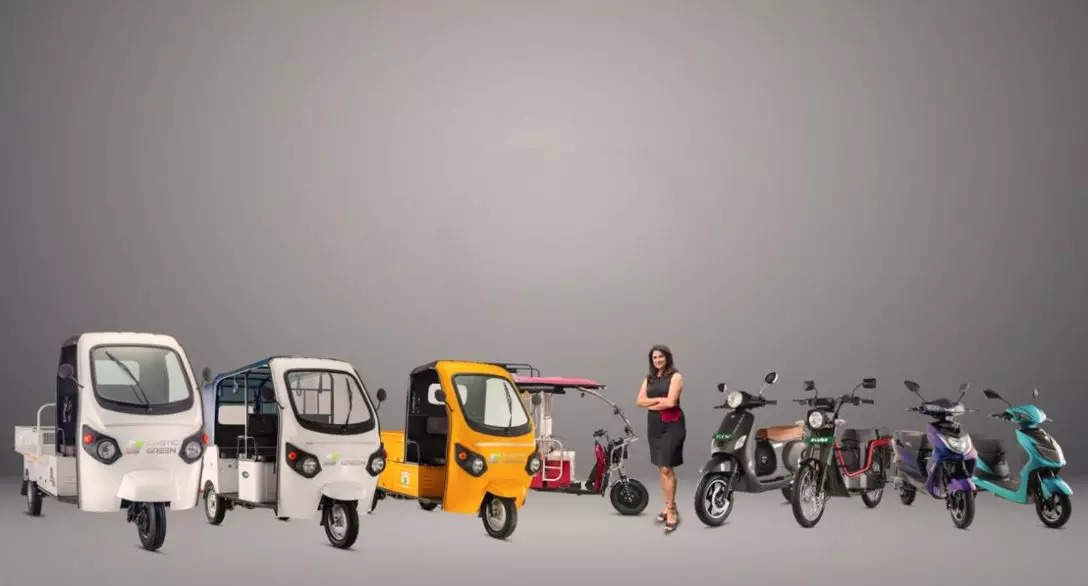
Collaboration is increasingly becoming the name of the game in the automotive industry. In yet another example, EV maker Kinetic Green is partnering with an American firm, for both the partners to tap opportunities in Africa, particularly in East Africa. Under the partnership, Kinetic will co-develop, and produce an e-motorcycle for its partner, which is also investing in setting up a battery swapping network. The identity of the partner is currently unknown. As part of the deal, Kinetic will tap the partner’s battery swapping network for e-Luna’s entry into the African market. These plans are expected to be realised next year. “We think it fits very well in our vision of ‘green mobility for millions’, which is making e mobility accessible to all, whether it’s India, or globally,” Sulajja Firodia Motwani, founder and CEO, Kinetic Green, told ETAuto.
The fresh fundraise of USD 25 million (around INR 212 crore) from the private equity firm Greater Pacific Capital will come handy for this move, but the major benefits of the PE investment will be for the product portfolio, and manufacturing capacity ramp up. The PE firm, the first external investor in the EV maker, secured a 12.7% stake with the investment.
Scaling up the 2W biz
A lot rides for Kinetic Green, on its flagship e-Luna two-wheeler EV. Launched in February, after seeding about 1,000 units in a trial period, the EV started selling from March-end, and has seen over 10,000 deliveries till date, according to the company. Of these, around 40% have been sold for B2B users.
“B to B is more in the big markets like Delhi, Bengaluru, Pune, and Ahmedabad, wherever the E commerce is really picking up. In B to C, it’s getting good response in tier two and tier three towns. And then we find that some vehicles actually move from there into the mofussil areas too,” says Motwani, who believes that smaller towns will fuel a new major growth for EVs, like they have adopted mobile phones and digital payment in a big way.
Kinetic Green plans to scale up monthly production from the current 3,000 units, to 4,000 next month, and 5,000 in October. The target is to touch 8,000 units by December, or “give or take one month”.
In the works are two variants of the e-Luna – one with LED lights, single seat, die cast wheels, positioned as an EV for urban mobility, and a higher performance variant for export markets. The latter will have bigger wheels (17-inch versus 16), and a bigger motor and battery pack. The current e-Luna, with a 1.2kW motor, has a top speed of 53-55 kmph, while the more powerful one, with a 2kW motor, will move faster at 70 kmph. It will share the same 3kWh battery pack.
A full size ‘family scooter’, on the lines of the erstwhile popular Kinetic Honda, is also on the drawing board, and is targeted for a market entry in another year and a half. “We were kind of waiting for the funding to get underway and then get on with it. But we’ve done research clinics. We know what we want to make,” says Motwani.
Betting on the India story
“If India has to be 30% EV (by 2030), 2- and 3-wheeler segments have to be 60% plus EV,” says Motwani. WIth the fresh investment in Kinetic Green, she’s bullish about the prospects of her company, which she feels is “well positioned”.
To tap the growth trend in the 2 and 3-wheeler segments better in the coming years, Kinetic Green invests in a new plant in Supa, Maharashtra. In the first phase, it will have an annual capacity of five lakh units, “which will be put in place right away”. By 2027, Kinetic Green plans to double the capacity to about 1 million EVs, “when we will also put in place a new BIW (Body in White) and paint shop at Supa.
Last year (2023-24), Kinetic Green sold around 35,000 units, with 25,000 of them being two-wheelers, and the rest three-wheelers. Banking mainly on the e-Luna on the two-wheeler side, the EV maker targets to more than double its annual volume to 75,000 units in 2024-25. An L5 category passenger carrier is also planned for addition to the three-wheeler portfolio, in the January-March ‘25 period.
Eyeing profitability in FY25
In FY24, which Motwani defines as “a particularly difficult year” due to multiple “headwinds for the EV sector”, including the FAME subsidy related investigations, Kinetic Green posted revenue of INR 300 crore, which is more or less the same as what it clocked the previous year. 60%-65% of the revenue came from the two-wheeler business.
Profitability came under more pressure during the year, with the loss figure widening to around INR 60 crore, from INR 7 crore the previous year. Expenses like the E Luna launch and its marketing, new manufacturing facility, building the team, weighed heavy during the year, according to Motwani.
“So I see it as an investment into the future, not as a loss-making business model. The business model still remains sustainability-focused,” she says while claiming that the contribution margin at the product level stood at 18% last year.
For the current year, with a top line target of INR 800 crore, the 8-year old Kinetic Green looks to book profit. What it also is looking for is a favourable policy support for the EV sector.
“There are still some uncertainties on policy consistency, etc., and we are hopeful that FAME III will come and the government will continue its support for E-mobility in terms of lower GST and other supports. However, our expansion plans, keeping in mind a favourable PV policy framework, I think, are very much realistic,” says Motwani.
And, at least some of these plans will be fuelled by the EV maker’s next round of fundraising, of USD 15 million, which is expected to close within “a few months”. Part of the investments will also fuel Kinetic Green’s joint venture with Italy’s Tonino Lamborghini, for golf carts and buggies.
















